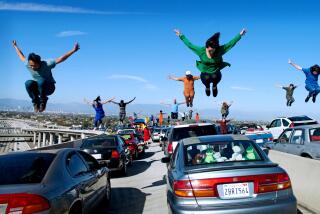Lost L.A.: Exposition Park’s Wee Hoose ‘Mang the Heather
- Share via
Exposition Park is a petting zoo of L.A. design. Sports venues and museums represent Beaux-Arts, Art Deco, postwar and post-postwar styles. On the way is a grim postmodern Metro stop. Sadly missing in this Soviet block of ponderous architecture is some Disney flair, L.A.’s unique tradition of entertainment style. Now that changes are being considered, city planners might remember the popular Wee Hoose ‘Mang the Heather.
The rose garden east of the Natural History Museum has been a public park since 1913. The California State Nurserymen’s Assn. oversaw its maintenance and ongoing planning. The arrangement was a good deal: Free plants for free publicity. Legendary nursery owner O.W. Howard was its chairman. In 1920 he and his colleagues decided that the four corners of the brick-walled terrace needed replanting in time for the annual flower show. The association settled on miniature landscapes, popular among the garden club set looking to design suburban yards. For his corner, Howard chose the theme of a cozy country cottage.
The idea came to him one evening. He was smoking his pipe and listening to the radio when he heard the lilting brogue of Scotsman Harry Lauder. He was singing his song about a Scottish house among the heather. America was a bonnie place, but back in the “auld country” there was a little “wee hoose ‘mang the heather” with a lassie waiting there for Lauder’s return. She was “the picture of perfection.”
Performers from Scotland and Ireland were warmly welcomed after those countries helped defeat the Germans in World War I. Lauder himself was no hick living in the moors. He had been a star since touring Europe and America, singing in music halls to raise money for the allied forces. Charlie Chaplin and Jimmy Durante welcomed the kilt-wearing minstrel to L.A. several times. He made a fortune and lived in a big hoose in a stony town outside Glasgow.
Having never visited Scotland, nurseryman Howard was sketchy about auld country anything. But this was Hollywood, and movie-going Americans were getting used to the inauthentic as real. As long as something looked and felt Scottish, it was Scottish.
On opening day of the 1921 California Flower Show and Horticultural Exhibition, visitors discovered Howard’s corner, created by a set designer for Jesse Lasky, co-founder of Paramount Studios. At the door to a thatched-roof cottage, built ‘mang some heather and a lot of sod, the Scottish mistress Mrs. Robert Liddell welcomed families to a cottage that she had decorated with family heirlooms. She and her husband, “the gentle shepherd,” lived in the hoose throughout the fair, playing parents to a Miss Brownlie. All three claimed to be related to historic celebrities, notably Bonnie Prince Charles.
They wore Scottish drag, performed the Highland Fling and sang along with a professional songster. Out back, ducklings splashed round the “Wee Loch Lauder.” There were pigs from a ranch in the San Fernando Valley, buff Cochin chickens and purebred pigeons. The Merritt H. Adamsons, builders of the landmark Adamson House in Malibu and owners of Adohr Stock Farms, lent Guernsey calves.
Howard merchandised his display with photographs. A purchase brought a tour of the cottage, a time-trip back to ye olde country. The plantsman apologized to native Scotsmen for any blunders they might discover, and he offered a Saturday evening of genuine Scottish song and music playing. He wished that Lauder could have been there to hear a heart-warming rendition of “There’s a Wee Hoose ‘Mang the Heather.”
A little cottage in a sunny garden, a real-life movie fully scored. It could be just the touch to make Exposition Park authentically Angeleno.
The hoose went down after the flower show, but you can still hear Harry Lauder sing at: https://www.archive.org. Type in “Harry Lauder” in the search field and scroll down to the “Wee Hoose” song.
More to Read
The biggest entertainment stories
Get our big stories about Hollywood, film, television, music, arts, culture and more right in your inbox as soon as they publish.
You may occasionally receive promotional content from the Los Angeles Times.










